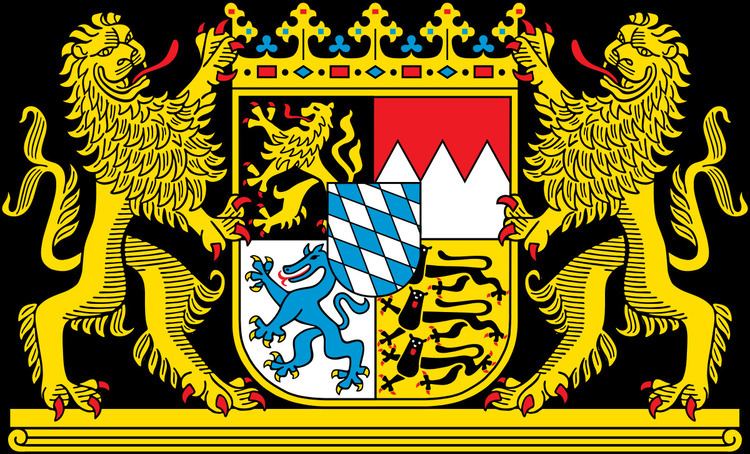Adopted 5 June 1950 | ||
 | ||
Escutcheon Quarterly: (1) sable, a lion rampant Or, armed and langued gules; (2) per fess indented gules and argent; (3) argent, a panther rampant azure, armed Or and langued gules; (4) Or, three lions passant guardant sable, armed and langued gules. Overall an inescutcheon fusilly in bend argent and azure. Supporters Two rampant lions Or langued and armed Gules | ||
The coat of arms of the German state of Bavaria has greater and lesser versions. It had been introduced by law fully by 5 June 1950:
Contents
Article 1 (2) The colours of the state are white and blue.
The meaning of the coat of arms
The modern coat of arms was designed by Eduard Ege, following heraldic traditions, in 1946.
History
Bavaria was one of the stem duchies of the Eastern Franconian Empire and the Holy Roman Empire. The House of Wittelsbach, who ruled in Bavaria for about eight centuries, used the coat lozengy since 1242, later quartering it with the lion of the Electorate of the Palatinate.
Bavaria became a kingdom in 1806, and in 1835 a new coat of arms was created, similar to today's but representing some regions by different coats of arms. The first known coat of arms of the house of Wittelsbach is Azure, a golden fess dancetty. When Louis I married Ludmilla, the widow of Albert III, Count of Bogen, he adopted the coat of arms of the counts of Bogen together with their land. The number of lozenges varied; from 15th century 21 were used, increasing to 42 when Bavaria became a kingdom in 1806.
Lit: Wilhelm Volkert; Die Bilder in den Wappen der Wittelsbacher. (Wittelsbach und Bayern, Köln, 1980)
Coat of arms of Kraiburg
In the eleventh century the counts of Kraiburg, a branch of the counts of Sponheim of Rhenish Hesse, acquired land in Upper and Lower Bavaria. In 1259, after the death of the last male member of the family, the shire was sold to the dukes of Bavaria. The coat of arms of the family was the "Lion of Sponheim", although the charge was not a lion but a "panthier" (pronounced French), a mixture of a dragon and a lion. Nowadays, the fire-spitting panthier/panther is the Coat of Arms of the city of Ingolstadt. The coat of arms created for the Kingdom of Bavaria in 1835 included the 'lion'.
